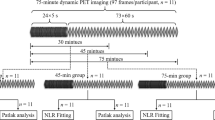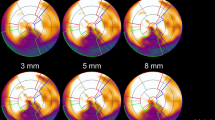Abstract
Purpose
Iterative reconstruction methods based on ordered-subset expectation maximisation (OSEM) has replaced filtered backprojection (FBP) in many clinical settings owing to the superior image quality. Whether OSEM is as accurate as FBP in quantitative positron emission tomography (PET) is uncertain. We compared the accuracy of OSEM and FBP for regional myocardial 18F-FDG uptake and 13NH3 perfusion measurements in cardiac PET.
Methods
Ten healthy volunteers were studied. Five underwent dynamic 18F-FDG PET during hyperinsulinaemic–euglycaemic clamp, and five underwent 13NH3 perfusion measurement during rest and adenosine-induced hyperaemia. Images were reconstructed using FBP and OSEM ± an 8-mm Gaussian post-reconstruction filter.
Results
Filtered and unfiltered images showed agreement between the reconstruction methods within ±2SD in Bland-Altman plots of K i values. The use of a Gaussian filter resulted in a systematic underestimation of K i in the filtered images of 11%. The mean deviation between the reconstruction methods for both unfiltered and filtered images was 1.3%. Agreement within ±2SD between the methods was demonstrated for perfusion rate constants up to 2.5 min−1, corresponding to a perfusion of 3.4 ml g−1 min−1. The mean deviation between the two methods for unfiltered data was 2.7%, and for filtered data, 5.3%.
Conclusion
The 18F-FDG uptake rate constants showed excellent agreement between the two reconstruction methods. In the perfusion range up to 3.4 ml g−1 min−1, agreement between 13NH3 perfusion obtained with OSEM and FBP was acceptable. The use of OSEM for measurement of perfusion values higher than 3.4 ml g−1 min−1 requires further evaluation.






Similar content being viewed by others
References
Hudson HM, Larkin RS. Accelerated image-reconstruction using ordered subsets of projection data. IEEE Trans Med Imaging 1994;13:601–9.
Riddell C, Carson RE, Carrasquillo JA, Libutti SK, Danforth DN, Whatley M, et al. Noise reduction in oncology FDG PET images by iterative reconstruction: a quantitative assessment. J Nucl Med 2001;42:1316–23.
Lonneux M, Borbath I, Bol A, Coppens A, Sibomana M, Bausart R, et al. Attenuation correction in whole-body FDG oncological studies: the role of statistical reconstruction. Eur J Nucl Med 1999;26:591–8.
Hogg D, Thielemans K, Mustafovic S, Spinks TJ. A study of bias for various iterative reconstruction methods in PET. Proc IEEE Nucl Sci Symp Medica Imaging 2002;1519–23.
Lubberink M, Boellaard R, van der Weerdt AP, Visser FC, Lammertsma AA. Quantitative comparison of analytic and iterative reconstruction methods in 2-and 3-dimensional dynamic cardiac 18F-FDG PET. J Nucl Med 2004;45:2008–15.
Schiepers C, Nuyts J, Wu HM, Verma RC. PET with F-18-fluoride: effects of iterative versus filtered backprojection reconstruction on kinetic modeling. IEEE Trans Nucl Sci 1997;44:1591–3.
Boellaard R, van Lingen A, Lammertsma AA. Experimental and clinical evaluation of iterative reconstruction (OSEM) in dynamic PET: quantitative characteristics and effects on kinetic modeling. J Nucl Med 2001;42:808–17.
Kuhle WG, Porenta G, Huang SC, Buxton D, Gambhir SS, Hansen H, et al. Quantification of regional myocardial blood flow using 13N-ammonia and reoriented dynamic positron emission tomographic imaging. Circulation 1992;86:1004–17.
Muzik O, Beanlands RSB, Hutchins GD, Mangner TJ, Nguyen N, Schwaiger M. Validation of nitrogen-13-ammonia tracer kinetic-model for quantification of myocardial blood-flow using pet. J Nucl Med 1993;34:83–91.
DeFronzo RA, Tobin JD, Andres R. Glucose clamp technique: a method for quantifying insulin secretion and resistance. Am J Physiol 1979;237:E214–23.
Gjedde A. Calculation of cerebral glucose phosphorylation from brain uptake of glucose analogs in vivo—a reexamination. Brain Res Rev 1982;4:237–74.
Patlak CS, Blasberg RG. Graphical evaluation of blood-to-brain transfer constants from multiple-time uptake data. Generalizations. J Cereb Blood Flow Metab 1985;5:584–90.
Hutchins GD, Schwaiger M, Rosenspire KC, Krivokapich J, Schelbert H, Kuhl DE. Noninvasive quantification of regional blood flow in the human heart using N-13 ammonia and dynamic positron emission tomographic imaging. J Am Coll Cardiol 1990;15:1032–42.
Wienhard K, Dahlbom M, Eriksson L, Michel C, Bruckbauer T, Pietrzyk U, et al. The ECAT EXACT HR—performance of a new high-resolution positron scanner. J Comput Assist Tomogr 1994;18:110–8.
Kuhle WG, Porenta G, Huang SC, Phelps ME, Schelbert HR. Issues in the quantitation of reoriented cardiac PET images. J Nucl Med 1992;33:1235–42.
Nitzsche EU, Choi Y, Czernin J, Hoh CK, Huang SC, Schelbert HR. Noninvasive quantification of myocardial blood flow in humans - a direct comparison of the [N-13]ammonia and the [O-15]water techniques. Circulation 1996;93:2000–6.
van der Weerdt AP, Klein LJ, Boellaard R, Visser CA, Visser FC, Lammertsma AA. Image-derived input functions for determination of MRGlu in cardiac F-18-FDG PET scans. J Nucl Med 2001;42:1622–9.
Hove JD, Iida H, Kofoed KF, Freiberg J, Holm S, Kelbaek H. Left atrial versus left ventricular input function for quantification of the myocardial blood flow with nitrogen-13 ammonia and positron emission tomography. Eur J Nucl Med Mol Imaging 2004;31:71–6.
Bland JM, Altman DG. Statistical methods for assessing agreement between 2 methods of clinical measurement. Lancet 1986;1:307–10.
Bland JM, Altman GG. Measuring agreement in method comparison studies. Stat Methods Med Res 1999;8:135–60.
Boellaard R, van der Weerdt AP, Knaapen P, Visser FC, Lammertsma AA. Strategies for improving the quantitative accuracy of post-injection transmission scans in cardiac PET. J Nucl Med 2001;42:196P.
Author information
Authors and Affiliations
Corresponding author
Rights and permissions
About this article
Cite this article
Søndergaard, H.M., Madsen, M.M., Boisen, K. et al. Evaluation of iterative reconstruction (OSEM) versus filtered back-projection for the assessment of myocardial glucose uptake and myocardial perfusion using dynamic PET. Eur J Nucl Med Mol Imaging 34, 320–329 (2007). https://doi.org/10.1007/s00259-006-0198-z
Received:
Accepted:
Published:
Issue Date:
DOI: https://doi.org/10.1007/s00259-006-0198-z




